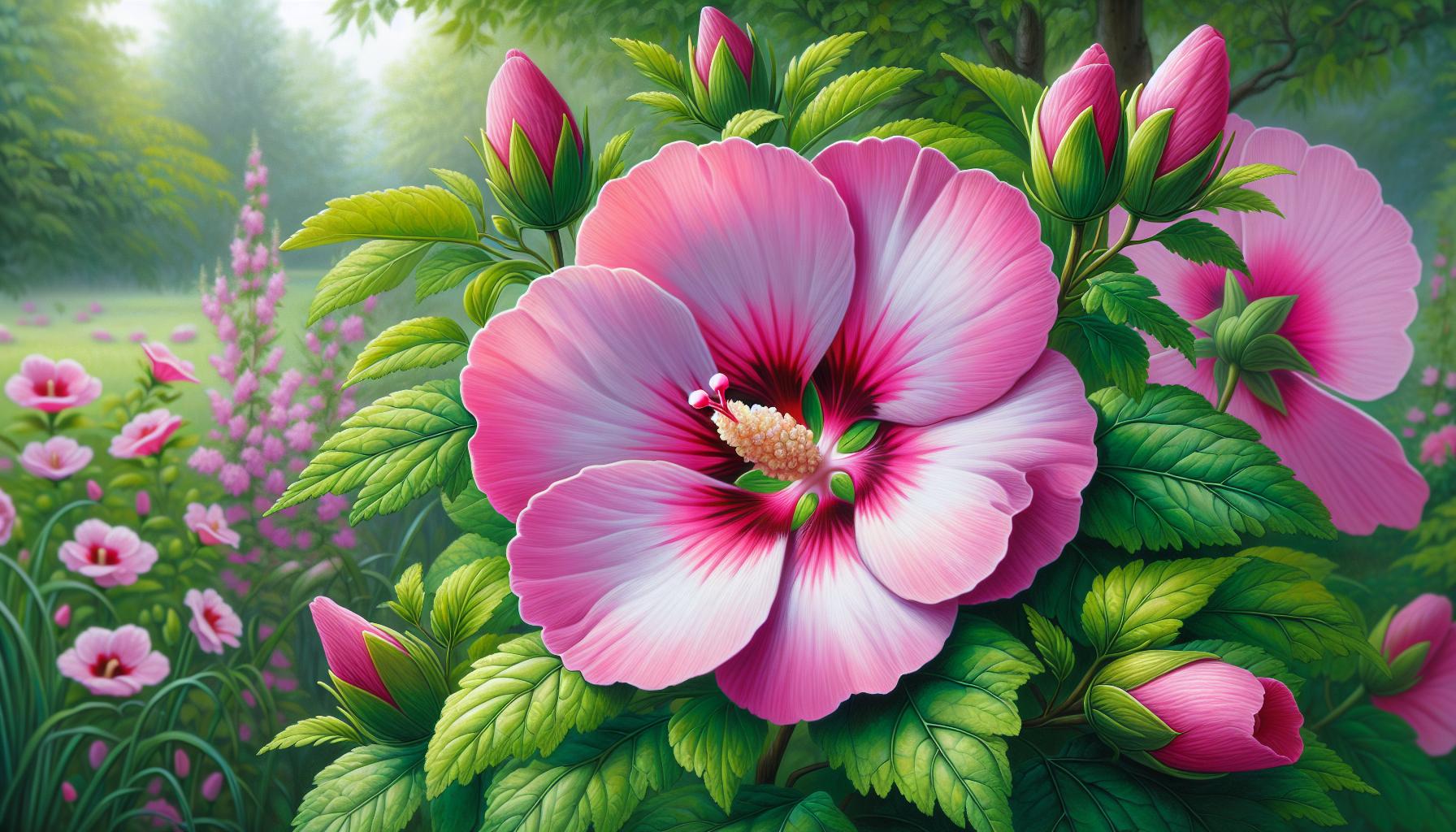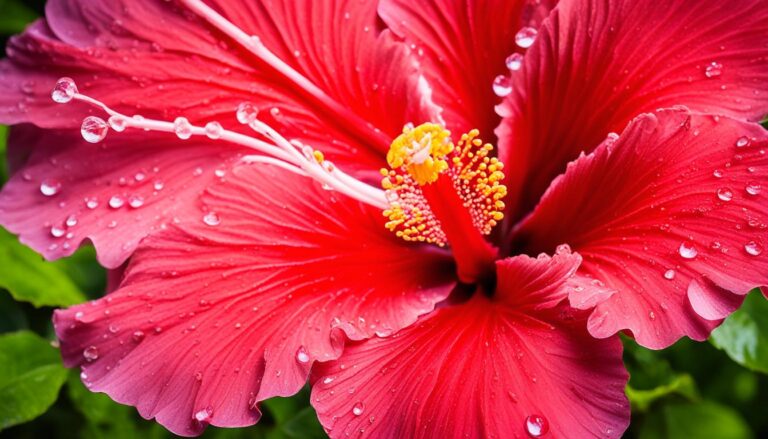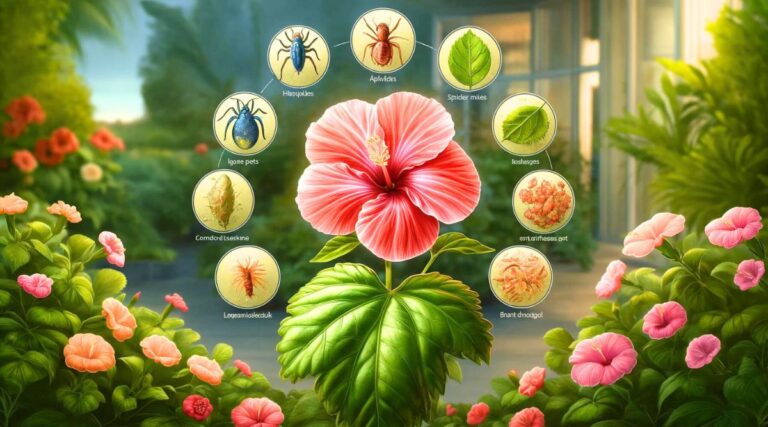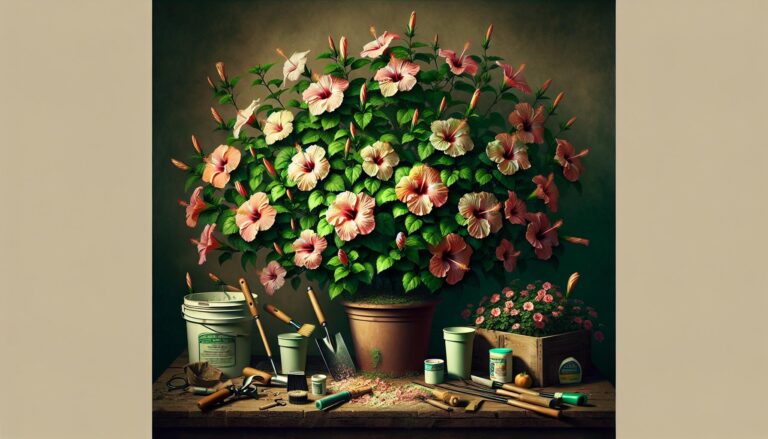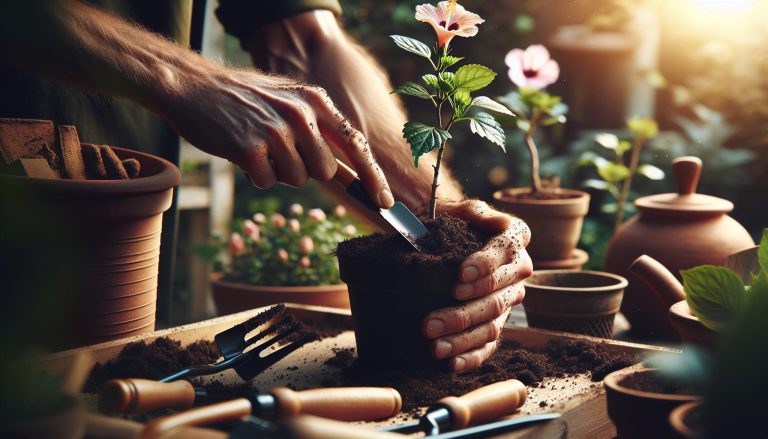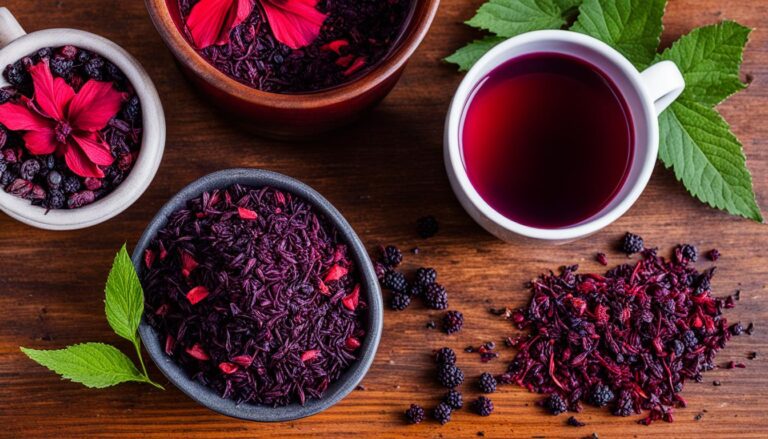Is Rose of Sharon a Hibiscus? Unraveling the Mystery
Navigating the vibrant world of Hibiscus can often feel like a botanical puzzle, especially with its dazzling array of species each flaunting a unique charm. Among the most intriguing questions we encounter is whether the Rose of Sharon is part of the Hibiscus family. This query isn’t just common—it’s a gateway to understanding the diverse and colorful universe of these flowering shrubs. With their ability to transform any garden into a slice of tropical paradise, it’s no wonder gardeners are keen to get their facts straight.
The confusion isn’t helped by the plethora of common names for Hibiscus species, from the Dinnerplate Hibiscus to the Rose of Sharon itself. Each species brings its own set of care needs, climate conditions, and growth habits, making it essential to distinguish one from another. We’re here to demystify this for you, shedding light on the differences between the Rose of Sharon, Chinese Hibiscus, and the Hardy Hibiscus, and guiding you towards making the best choice for your garden. Let’s dive into the heart of this floral mystery and clear up the confusion once and for all.
Key Takeaways
Understanding the Rose of Sharon
Botanical Background
In our journey to demystify the Hibiscus genus, the Rose of Sharon (Hibiscus syriacus) stands out as a significant member. Originating from China and widely recognized by its variety name ‘Althea’, this plant indeed belongs to the Hibiscus family. It thrives in USDA hardiness zones 5-8, reaching a mature size of 8-12 feet in height, aligning with the defining characteristics of Hibiscus species in terms of its growth habit and environmental preferences. Notably, the Rose of Sharon is celebrated for its easy cultivation and the beauty it adds to the landscape with its impressive blooms.
Common Misconceptions
A common misconception is that all Hibiscus plants are tropical. However, contrary to this belief, the Rose of Sharon is a testament to the genus’s versatility. This particular species adapts remarkably well to temperate climates, showcasing the diverse adaptability within the Hibiscus family. Additionally, while it shares the genus with the likes of Chinese Hibiscus (Hibiscus rosa-sinensis) and Hardy Hibiscus, each species possesses unique care requirements and environmental tolerances. This distinction underscores the importance of recognizing the Rose of Sharon as a hardy, temperate member of the Hibiscus family, rather than lumping it together with its tropical relatives.
Is Rose of Sharon a Hibiscus?

In the quest to untangle the complexities of the Hibiscus family, a frequent question arises: Is the Rose of Sharon actually a Hibiscus? Given the array of species within this plant genus and the nuances of their care, it’s crucial to affirm the botanical relationship between the Rose of Sharon and the broader Hibiscus genus.
Examining the Genetic Link
Diving into the genetic lineage, we find that the Rose of Sharon (Hibiscus syriacus) is indeed a member of the Hibiscus genus. Originating from China, this plant has established itself as a hardy, versatile species within the Hibiscus group. Its adaptability across USDA hardiness zones 5-8 showcases its temperate nature, distinguishing it from its predominantly tropical counterparts. This revelation not only highlights the genetic bridge connecting the Rose of Sharon to other Hibiscus varieties but also reinforces the importance of recognizing the diversity and adaptability within this plant family.
Our examination illustrates that despite the varying climate requirements, growth habits, and care needs among the Hibiscus species, there exists a fundamental genetic congruence. This commonality underscores the need for gardeners to approach Hibiscus care with an understanding of each species’ unique traits while appreciating their shared heritage.
Visual and Botanical Comparisons
When we consider the appearance and botanical characteristics, the distinction between the Rose of Sharon and other Hibiscus species becomes more nuanced. Hibiscus syriacus, with its distinctive blooms that come in shades of pink, white, and purple, offers a visual testament to its Hibiscus lineage. The flower’s structure, consisting of a prominent stamen and pistil, mirrors that of other Hibiscus varieties, cementing its place within the genus.
Botanically, the Rose of Sharon exhibits an upright growth habit, reaching heights of 8-12 feet and adapting well to a range of soil types and environmental conditions. This trait contrasts with the sprawling nature of some tropical Hibiscus species, which thrive in warmer climates. Additionally, the leaf type, arrangement, and fall characteristics provide further differentiation points that help gardeners identify and cater to each species’ specific needs.
In closing, our exploration underlines that the Rose of Sharon is undeniably a Hibiscus, sharing both a genetic and a botanical kinship with its relatives. Understanding this connection enables gardeners to better appreciate the diversity within the genus and to apply tailored care strategies that reflect each species’ unique requirements.
Cultural and Historical Significance

In Gardens and Literature
The Rose of Sharon, scientifically known as Hibiscus syriacus, holds a revered place not only in gardens worldwide but also in literature. This species, with its diverse color palette and extended blooming period, has inspired gardeners to integrate it into varied landscaping themes, striving for a cohesive look that embraces both its beauty and versatility. Historically, the Rose of Sharon has been a symbol of renewal and fleeting beauty, themes echoed in literary works across cultures. Its presence in literature is often associated with the cycles of life and the delicate nature of existence, making it a potent symbol for writers and poets.
Symbolism and Uses
Beyond its aesthetic appeal, the Rose of Sharon carries profound symbolism. In several cultures, it is seen as a symbol of femininity, due to its soft, yet striking, blooms that display resilience and elegance. This symbolism extends to various uses, where the Rose of Sharon has found its way into ceremonies and traditions as a representation of purity, beauty, and the strength of the female spirit. Additionally, its propensity to produce sterile flowers, particularly noteworthy in the Chiffon family, signifies the value of beauty without the need for procreation, further entrenching its status as a primarily ornamental plant that enhances gardens without the worry of uncontrolled spreading.
Our understanding of the Rose of Sharon, from its botanic features to its cultural and historical significance, enriches our appreciation for this plant. Recognizing its place in gardens, literature, and symbolism, provides a deeper insight into how this hibiscus species has captivated humans through the ages.
Growth and Care Guide

Understanding the Rose of Sharon’s growth and care guide will allow gardeners to appreciate not only its historical and cultural significance but also its botanical needs and potential in home gardens. In this section, we delve into the optimal conditions for growth and share tips for maintaining these beautiful plants.
Ideal Conditions
Rose of Sharon thrives in full sunlight with well-drained soil, showcasing its adaptability to various soil conditions except for continually wet, marshy, or overly sandy soils. These plants can tolerate a broad range of pH levels, making them suitable for many garden settings. Importantly, they require ample sunlight to bloom profusely; while they can manage partial shade, too little light may reduce flower production and increase susceptibility to bacterial leaf spotting.
For optimal growth, Rose of Sharon enjoys a location that provides protection from harsh, drying winds. This positioning helps in maintaining moisture without the risk of root rot, which is common in poorly drained soils. Ensuring that your Rose of Sharon receives the right environmental conditions from the start will enhance its performance, making it a standout addition to any garden.
Maintenance Tips
Maintaining a Rose of Sharon requires a blend of attention and letting nature take its course. Once established, these shrubs are relatively low-maintenance but benefit from certain care practices:
- Watering Needs: In their early stages, regular watering helps establish roots. However, mature plants showcase drought tolerance, needing supplemental water only during extended dry spells. Avoid overwatering, as this can lead to root problems and yellowing of the leaves.
- Mulching: Applying mulch around the base of the plant not only retains soil moisture and regulates temperature but also prevents weed growth. A layer of organic mulch can enrich soil nutrients over time, promoting healthier growth.
- Pruning: Pruning is not strictly necessary for the health of Rose of Sharon, but it can help maintain a desired shape and size. It’s best to prune in late winter or early spring before new growth begins. This timing allows gardeners to remove any dead or broken branches and encourages more vigorous growth and blooming.
- Feeding: A top dressing of compost in spring provides the necessary nutrients for the season ahead. Avoid autumn fertilizing to prevent new growth that could be damaged by early freezes.
- Pest and Disease Management: While relatively resistant to pests and diseases, watching for signs of trouble, such as leaf spots or aphid attacks, is crucial. Early detection and intervention can prevent further damage.
By following these maintenance tips, you can ensure that your Rose of Sharon continues to provide beauty and elegance to your garden year after year. Whether you’re drawn to its rich history or the simple allure of its blooms, Rose of Sharon makes a valuable addition to any garden seeking both aesthetic appeal and botanical interest.
Popular Cultivars and Varieties

Characteristics and Selection
When we dive into the realm of Hibiscus cultivars, particularly those that include the Rose of Sharon, it becomes evident how diverse this plant family is. Among the oldest and most beloved cultivars stands Lord Baltimore, showcasing massive petals in a deep red hue. In contrast, varieties like Luna White and Luna Rose present more delicate tones, with Luna Swirl mixing the two colors in an intriguing pattern. The recent cultivar, Starry Starry Night, brings to light the epitome of Hibiscus beauty with a red center surrounded by white and pink streaked petals.
Selecting the right Hibiscus variety for your garden involves considering a few key characteristics. First, flower color and size hugely impact the visual appeal of the plant, as demonstrated by the cultivars mentioned. Additionally, blooming period and plant dimensions play critical roles, especially for gardeners with space constraints or specific design goals. For instance, the larger Syriacus varieties often serve well as privacy screens due to their sizeable growth.
Design and Planting Ideas
Incorporating Hibiscus, particularly the Rose of Sharon, into garden design affords numerous opportunities for creativity and expression. These plants thrive in theme gardens, echoing an old-fashioned cottage garden style splendidly. To achieve such a look, planning involves thick planting to let the plants grow together, creating a lush and somewhat chaotic display of color and form. Working within a defined color palette can tame this perceived chaos, allowing for a harmonious setting that still captures the garden’s vibrant spirit.
Cottage gardens champion personal expression, with no stringent rules on plant selection. A palette of blue, lavender, white, and silver flowers, or perhaps a more dynamic array involving reds, yellows, and oranges, can set the tone. Rose of Sharon plants integrate seamlessly when positioned alongside traditional cottage garden flowers like alliums, roses, lavender, foxglove, coreopsis, and echinacea.
Key to successful garden design with Hibiscus varieties is understanding each plant’s potential growth and bloom span to ensure they complement rather than compete with surrounding plants. This strategic approach allows gardeners to leverage the plant’s ornamental value while ensuring the garden remains cohesive and visually appealing throughout the blooming season.
Environmental Considerations
As gardeners, we’re not just crafting beautiful spaces; we’re engaging with the broader environmental tapestry. This connection leads us to delve into the environmental considerations surrounding the growth of Rose of Sharon, a popular yet often misunderstood member of the Hibiscus genus. Understanding this plant’s impact on our local ecosystems and biodiversity is crucial for sustainable gardening practices.
Invasive Species Concerns
While the Rose of Sharon (Hibiscus syriacus) is admired for its sheer beauty and adaptability, there’s a pivotal discussion around its invasiveness in non-native areas. Known for its vigorous growth and prolific seed production, this plant can potentially disperse into wild areas. In certain regions, the Rose of Sharon has shown a tendency to spread beyond the confines of garden spaces, which raises concerns about it overshadowing native flora.
Local ecosystems thrive on a delicate balance, and the introduction of non-native species can disrupt this equilibrium, leading to decreased biodiversity. It’s critical to check with local gardening groups, conservation societies, or agricultural departments to determine if the Rose of Sharon is considered invasive in your area. If it is, we recommend seeking native or less aggressive alternatives to fulfill your gardening aspirations without compromising ecological integrity.
Biodiversity and the Garden Ecosystem
Biodiversity in the garden provides a myriad of benefits, from enhancing the aesthetic appeal of your space to contributing to the health of the planet. The Rose of Sharon, due to its non-native status in some regions, may not always align with the goals of promoting local wildlife and plant diversity. It’s essential to consider how your choice of plants affects the garden’s ecosystem.
Incorporating native plants alongside or instead of Rose of Sharon can offer improved habitats and food sources for local wildlife, including birds, bees, butterflies, and other beneficial insects. These native species are often well-suited to the local climate and soil conditions, requiring less water, fertilizer, and maintenance, thereby promoting a more sustainable gardening practice.
The presence of a diverse array of plants supports a healthy garden ecosystem, fostering interactions that strengthen the resilience of your garden to pests and diseases. As we choose plants for our gardens, understanding their environmental impact allows us to contribute positively to our local ecosystems, ensuring our green spaces not only bring joy to us but also contribute to the well-being of the planet.
In our commitment to environmental stewardship, evaluating the Rose of Sharon’s role in our gardens involves a nuanced understanding of its beauty and potential challenges. By making informed choices, we can enjoy the splendors of gardening while harmonizing with the natural world.
Conclusion
As we’ve explored the intricate relationship between the Rose of Sharon and the Hibiscus genus, it’s clear that understanding the nuances of our garden choices goes beyond aesthetics. By embracing the diversity within the Hibiscus family, we open our gardens to a world of cultural and ecological richness. Opting for informed selections allows us to not only beautify our spaces but also contribute positively to local ecosystems. Let’s continue to make choices that reflect our commitment to sustainability and ecological integrity, ensuring our gardens are places of beauty and environmental stewardship.
Frequently Asked Questions
Are there two types of Rose of Sharon?
No, there are numerous varieties of Rose of Sharon with variations in plant size, flower size, flower type (single vs. double), and color. For example, ‘Diana’ has large, pure white flowers and blooms for an extended period during summer.
Is Rose of Sharon invasive?
Yes, the Rose of Sharon can be considered invasive in some areas since it competes with native plants for sunlight, water, and nutrients, potentially harming local ecosystems and wildlife dependent on native species.
Can you use Rose of Sharon for hibiscus tea?
Yes, Rose of Sharon (Hibiscus syriacus) is related to the traditional Hibiscus rosa-sinensis used in hibiscus tea, hence it shares similar nutritional benefits like being a source of vitamin C.
What type of flower is the Rose of Sharon?
Rose of Sharon is not actually a rose, but a flowering shrub native to parts of Asia. Known scientifically as Hibiscus syriacus, it belongs to the mallow family and is related to tropical hibiscus. It is also referred to as shrub althea or hardy hibiscus.
What are the medicinal uses of Rose of Sharon?
The Rose of Sharon has several medicinal uses: its leaves act as a diuretic, expectorant, and stomachic, while a decoction of the flowers can also be diuretic and is used in treating itch, skin diseases, dizziness, and digestive issues marked by bloody stools and excessive gas.

